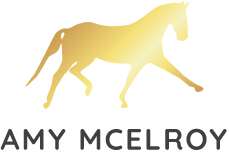Dear Amy,
I am an adult amateur dressage competitor and will be competing throughout the summer months at Second Level. Although I don’t mind the heat too much, I am concerned about the sun on my skin and eyes. I wondered about the following dress codes. Can I warm up and compete with a wide brimmed visor attached to my helmet? Can you wear sunglasses? Can you compete in a long sleeve shirt and do I need to wear a belt when I do not wear a show jacket? Can you please confirm the protocol?
I also have a question about performing my test. I am not clear when riding the shoulder-in movement in the Second Level tests when and if I am supposed to straighten my horse. I have seen this ridden many different ways. Could you please explain how this movement should be ridden?
SPF 100
Dear SPF 100,
It certainly does get warm in the summer months and the sun can be a concern especially as it really does reflect off the riding surfaces. I am happy to answer all your concerns in this column. Keep in mind that a useful source of information is the USEF rulebook. Look under the Dressage Division for Dress (DR120). It is advisable to check the rules yearly as they may change and sometimes they even adjust midyear.
Let’s start with the attachable sun visor for your helmet. It is permissible to wear this visor while schooling your horse in the warm-up arena. Unfortunately it is currently illegal to wear this visor in the competition arena as it is considered an “attachment/gadget.” Wearing a visor is a dress code violation, however it is up to the discretion of the judge whether or not to eliminate you for wearing it. It is, of course, most important and mandatory to wear protective headgear that is properly secured.
As far as wearing sunglasses or any glasses, there currently is no ruling. You may wear your sunglasses in the warm-up as well as the competition arenas. Please make sure they are securely on your face and are not bouncing around since this can be distracting to you and to your judge.
When jackets are waived, there are many rules to follow. Currently, there are no rules about what types of shirts you may wear in the warm-up. However, when you enter the competition arena, this changes. A long sleeved shirt is always permitted, whether you wear a jacket or not. If you are not wearing a jacket, remember that your shirt must have a collar – T-shirts, whether short or long sleeved, are not permitted when riding without a jacket. You should not wear any neck gear (stock ties, chokers, etc) when not competing in your jacket. But if you do wear a jacket, neck gear is mandatory.
Currently, wearing a belt is a matter of personal preference, whether you are in the warm up ring or the competition arena. There is not a USEF rule. It is advisable to look neat and always at your best, but you are free to decide if you look better with a belt or without one.
If you have a question about rules while you are at your competition, you can always confer with the technical delegate (TD) to discuss the situation. Part of the TD’s job is to help you. I hope this answers all your dress code questions.
Now let’s look into your questions regarding shoulder-in at Second Level.
The shoulder-in is an important lateral movement that is first required in the Second Level tests. It is important to know how to ride and how to finish this movement correctly. There are three Second Level tests and the shoulder-in patterns are different in each of them so they have different endings.
First, let’s look at what the rulebook has to say about the shoulder-in, and then we can discuss how these guidelines apply to the specific tests you will be riding.
According to the USEF rulebook DR 111.f: “If the shoulder–in is performed on the long side or on the centerline, the horse should be straightened after the shoulder-in, before going into the corner. If the movement that follows the shoulder-in is a circle at any point, or a turn left or right at any point other than the four corners, the horse should not be straightened.
Let’s start with Second Level, test one. You start at K, which is the first letter on the long side after the corner. The movement states “K to E shoulder-in right and E turn right.” Therefore, you would NOT straighten your horse after the shoulder-in as you would be immediately going into a turn, and your horse should be bent to the right. The next shoulder-in pattern goes “B to M shoulder-in left.” This time, since M is the last letter on the long side before the corner, you DO straighten at M before you go into the corner.
In Second Level, test two, shoulder-in right is ridden from M (the first letter on the long side) to B (the middle letter on the long side.) Then, at B you make a half circle of 10 meters to the right. Since you will be riding directly into a 10-meter circle you would NOT straighten your horse. The shoulder-in left starts at F (also the first letter on the long side) and goes to B, followed directly by a half circle of 10 meters to the left. Again, since you go immediately into a half circle you do NOT straighten your horse.
In Second Level, test three, the shoulder-in is ridden similarly to Second Level test two: the shoulder-in both directions goes immediately into a 10-meter circle, therefore you DO not straighten your horse at the end of the movement.
I hope this helps clarify things for you. Put on your sunscreen and sunglasses and have a wonderful ride.

